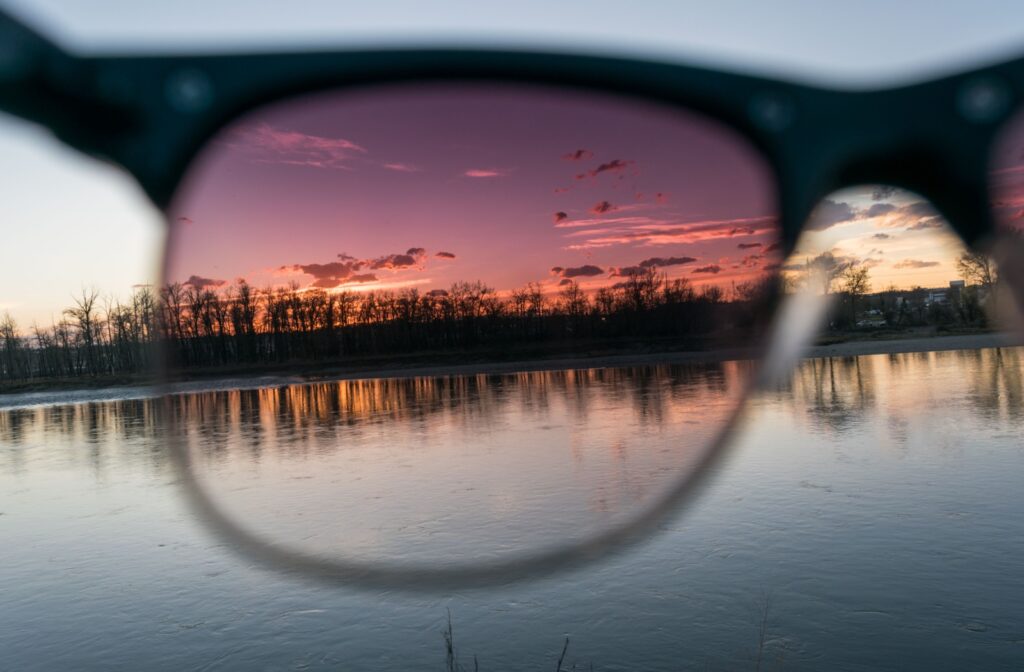Vision matters, no matter where life takes you. If you value crisp views, reduced glare, and optimal eye protection, polarized sunglasses might already be on your radar. A few ways that you can tell if your sunglasses are polarized include:
- The LCD screen test
- The reflection test
- Comparing them with known polarized lenses
- Checking the manufacturer’s tag
- Asking your eye doctor
The difference between regular lenses and polarized sunglasses is typically substantial in specific settings. So, one of these methods should provide an answer to whether your sunglasses are polarized or not.
What Are Polarized Sunglasses?
Polarized sunglasses are a step above the typical pair of shades. These specialty lenses are designed to combat glare, that harsh reflection of light that bounces off shiny surfaces like water, car hoods, or snowfields.
Polarized lenses can improve clarity, reduce eye strain, make colors seem more vibrant, and provide a more comfortable visual experience overall in high-glare or reflective environments.
Whether you’re driving, enjoying a sunny day on the lake, or skiing down bright slopes, polarized sunglasses work to protect your eyes while keeping your vision sharp and glare-free.
Understanding Polarized Lenses
When sunlight bounces off horizontal surfaces, such as water or pavement, the reflected light can result in an uncomfortable glare.
Polarization works by filtering out light waves that vibrate in specific directions. Polarized lenses contain a special chemical coating that blocks horizontally polarized light—typically reflected from flat surfaces like roads or water—while allowing vertically polarized light to pass through. This process significantly reduces glare and enhances visual clarity and contrast.
Testing for Polarized Lenses
There are several ways to determine if your sunglasses have polarized lenses.
The LCD Screen Test
A quick and reliable home test involves a digital device. Here’s how you can use an LCD screen, like your phone or computer monitor, to check for polarization:
- Find an LCD screen: Use your phone, tablet, or even the screen from your laptop
- Hold the glasses up: Place your sunglasses so that the lenses face the screen, as if you were wearing them
- Rotate the glasses: Slowly tilt the sunglasses at a 60–90 degree angle while keeping them in front of the screen
If the lenses are polarized, you’ll notice that the screen colors darken or become distorted as you rotate the glasses. In some cases, you may not even be able to see what’s on the screen anymore. That’s because the polarizing filter interacts with the light from the LCD, which is also polarized.
If the screen shows no change as you tilt the glasses, they’re probably not polarized.
The Reflection Test
Another simple way to test your sunglasses for polarization is to use reflective surfaces like water, glass, or even a polished table.
- Find a reflective surface: Look at a horizontal, shiny surface, such as a pool of water, a car window, or a glossy countertop
- Observe the reflection: Examine how the light interacts with the reflective surface with your sunglasses on
- Tilt your head: Rotate your head slightly left or right while keeping your eyes on the same spot
When viewed through polarized lenses, the light reflecting off the water should be significantly reduced. This happens because the lenses filter out the horizontal light that causes the glare. Non-polarized lenses will show little to no difference.

Compare with Known Polarized Sunglasses
If you have another pair of polarized sunglasses, you can compare them. Try wearing each pair in similar settings and looking at a source of glare, such as sunlight bouncing off water or glass.
Notice the differences. True polarized lenses should reduce the light from glare more effectively and provide a sharper, crisper view.
Check for a Polarization Sticker or Tag
Many polarized sunglasses come with identifying stickers or tags when new. Look for descriptors like “Polarized” printed on the lens, packaging, or included product information. While not foolproof since stickers can be misleading in counterfeit pairs, it’s a quick clue worth checking.
Consult a Professional
If you’re still uncertain, an optometrist or eyewear professional can help you check your sunglasses. Most optical stores have tools to quickly verify if lenses are polarized. Additionally, a professional can make sure that your sunglasses meet quality standards for adequate eye protection.
Why Polarized Sunglasses Are Worth It
Are polarized sunglasses worth it? Here are a few situations where they could be valuable:
- Driving: Reduced glare from other vehicles and wet roads improves road safety
- Fishing: Spot fish beneath the water’s surface without being blinded by the sun’s reflection
- Skiing and snowboarding: Navigate snowy terrains without the overwhelming brightness of sunlight on snow
- Boating: Enjoy long hours on the water without eye strain
Polarized sunglasses can enhance the experience and protect your eyes in these scenarios, making them a must-have for many outdoor enthusiasts.
Keep Your Vision Glare Free
Now that you know these simple methods to test polarization, there’s no need to compromise on quality eyewear.
If in doubt, don’t hesitate to consult your eye doctor for confirmation. Your eyes deserve the best, and proper polarized sunglasses are a small investment for improved vision and protection while enjoying the great outdoors in the Texas sun.
Stop by Eye Care Plus today and let our team help you determine if your sunglasses are polarized. And if you’re looking for new sunglasses, we can help you choose the best ones for your needs with the correct prescriptions, so you don’t have to choose between protecting your eyes and seeing clearly. We’ll help you find sunglasses that protect your eyes and give you the clarity you need—no compromise necessary.



